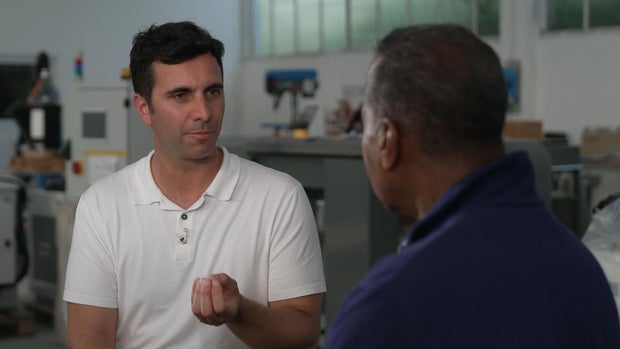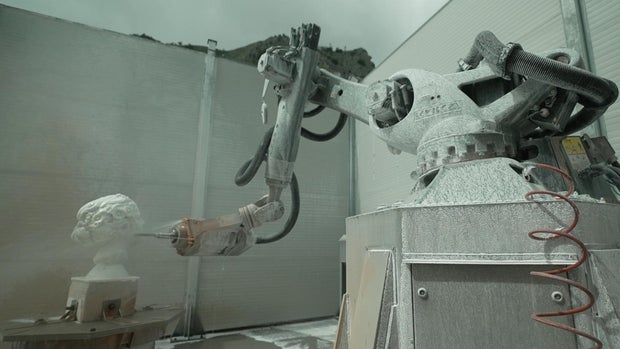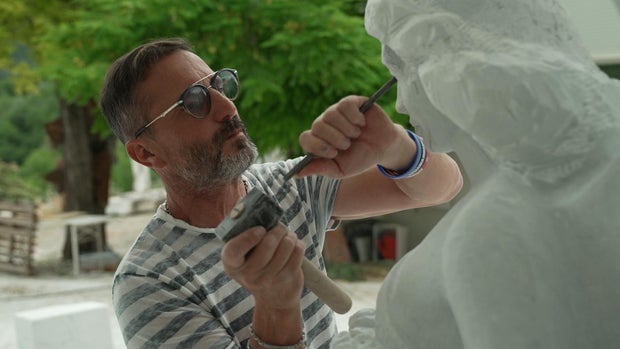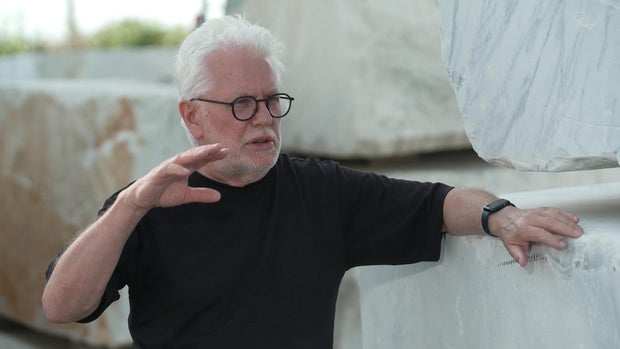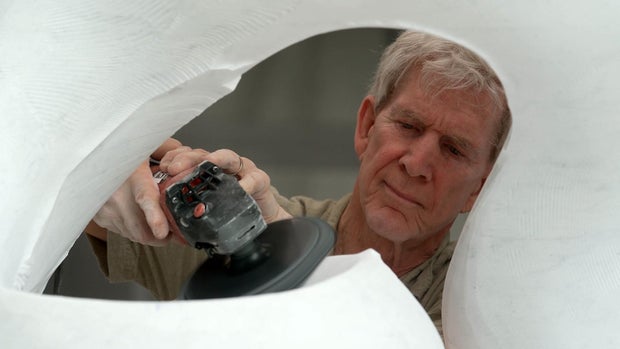Robots chisel out the future of sculpture as some artists embrace change and others push back
In 1497, an ambitious 22-year-old hiked up to the quarries above the Italian town of Carrara looking for a perfect block of marble. He searched for months until he found it. His name was Michelangelo, and the marble became his immortal, "The Pieta." Since then, many other giants—think Bernini, Canova—have put their chisels to Carrara stone. Now, there's an upstart. And like his star predecessors, he goes by a single name: Robo. Robo is part of a fleet of robots shaking up the art world, carving with pinpoint precision, and in record time. But not everyone is happy. One artist told us, Michelangelo would be rolling in his grave.
The jagged ridges of the Apuan Alps stretch for 30 miles across northern Tuscany. Even in summer, their dazzling peaks seem covered in snow. But get up close. It's not snow—it's marble. Peel away the forests, wash away the soil, you'll find whole mountains of the most sought-after marble in the world.
Bill Whitaker: It's remarkable.
Giacomo Massari: Yes. We are now approaching the Ravaccione Valley—the valley where you can find the stones that Michelangelo used in the past.
We were traveling with Giacomo Massari, the CEO and co-founder of Robotor, a company that makes robots that sculpt.
Bill Whitaker: Some of this is in the statue of David?
Giacomo Massari: Yes.
This was Michelangelo's old stomping grounds. We passed quarry after quarry. There are more than 600 above Carrara. The glare from the gleaming rock was intense, when suddenly we hurtled into darkness…
Bill Whitaker: Look at this.
…. a tunnel cut straight into the heart of a marble mountain. We drove until we could go no farther.
Giacomo Massari: Our work starts from here. The first hard part is to get the stone.
We reached what quarrymen call the Cathedral.
Giacomo Massari: Yeah, let's try not to fall.
The track down was slimy with marble mud.
Giacomo Massari: The Cathedral.
Bill Whitaker: This is mind-blowing.
From the floor, walls of stone towered above us. Giacomo Massari told us Carrara's miners had hollowed out the vast cavern over 200 years. We'd come to see Robotor's next project: a monumental block of marble about the size of a railway car—200,000 pounds of flawless Carrara stone.
Bill Whitaker: You're going to move this block out of here?
Giacomo Massari: We are going to move this big boy out of here.
Bill Whitaker: How?
Giacomo Massari: They're going to be a couple of cranes and a huge truck to lift it.
A feat not possible in Michelangelo's time. But then, neither was this:
Meet Robo. One of the brigade of robots taking over sculpture. We watched as Leonardo da Vinci's trademark hat was adjusted. Not with a hammer and chisel, but a 13-foot zinc alloy arm and a spinning diamond-crusted finger. Water jets kept Leonardo cool. This was a week's work for Robo with another two to go.
Bill Whitaker: So, if you were doing this the old-fashioned way, hammer and chisel, how long would this take?
Giacomo Massari: Ten times more, at least.
Bill Whitaker: Ten times longer?
Giacomo Massari: Yeah, absolutely.
Massari told us his mechanical employees—seven and counting—don't sleep, get sick, or take holidays. He took robots off the automotive line and gave them bigger brains.
Robotor's chief technician, also a sculptor, turns the artist's model into a 3D file. That generates a complex set of instructions that tells the robot exactly where to carve—right down to the last half-inch.
Bill Whitaker: How much of the work is done by the robot and the computer, and how much by the human artist?
Giacomo Massari: We are talking a very high percentage that can be done by the machine.
Bill Whitaker: Like how much?
Giacomo Massari: Like, 99 percent.
Bill Whitaker: 99 percent?
Giacomo Massari: Yeah. And the very final 1% that is the most important is still done by very skilled artisans in our workshop.
Just one percent? But that one percent, Massari told us, can translate into months of human work. Still, we wondered, was using a robot a bit like cheating?
Bill Whitaker: If you have a robot doing 99 percent of the work, where's the artistry?
Giacomo Massari: In the idea. How you program the machine is a work of art because it's an artistic approach. You need to have a sculptural background to program the machine in the way that you want.
Massari says Michelangelo—like other A-listers—employed dozens of apprentices who worked anonymously behind the scenes. Now, it's the robots' turn. But not every artist wants to admit they have a robot on the payroll. There was work we couldn't film, commissioned by big-name artists who insist their identities remain secret.
Bill Whitaker: Why is that?
Giacomo Massari: I think they are afraid. Because most of the people if you, if you ask a direct question, "Do you like that this artwork is made by a robot, yes or no?," nine out of ten will say no.
Bill Whitaker: Do you think that people would think "the robot's doing all the work?"
Giacomo Massari: Yes. But it doesn't make your idea weaker or stronger. If your idea is bad, you can make it with a robot or make it by hand, still the final artwork will be bad. But if your idea is good, if you make it with a robot or not, it will be still good.
But Tuscan artist Michael Monfroni told us only a human touch can coax the divine out of a stone…and that sounds like this:
Monfroni told us, Michelangelo would never lower himself to using a robot, and neither would he – and he says, he despairs at seeing the master's work being copied by robots.
Michael Monfroni (Monfroni speaking in Italian/Whitaker translation) It's sacrilege, he told us. Sculpting is passion. Robots are business.
Monfroni first picked up a chisel at age 7, learning the trade from his father. Now those skills are on the brink of extinction.
Bill Whitaker: You have said if you use a machine, you become a machine.
Michael Monfroni (Monfroni speaking in Italian/Whitaker translation) Yes, because your mind is limited by the technology, he told us. It's only a computer program transmitted to the robot. You lose the satisfaction of having created a piece of art by hand.
Monfroni is not alone. The prestigious Sculptors' Guild of Carrara is dead set against robots too. They warn that Italy's artistic heritage is at risk.
Barry X Ball: There is a conservative mindset that wants to hold on to some imagined, ancient way of approaching art that's mystifying to me.
Barry X Ball is a contemporary artist based in New York City. He uses eye-popping stone to make works that have been shown at major museums around the world. He's a regular shopper here in Carrara. These blocks go for about $300,000, and on a recent trip, he bought a robot too. Ball told us, he's come under fire for using them.
Barry X Ball: I hear a kind of fear that's almost like "they're gonna take our way of making sculpture away from us." Not trying to do that. We're trying to add to it.
Bill Whitaker: I know you've heard the criticism, that this is cheating. What do you say to the people who think that?
Barry X Ball: Number one they don't understand the process. They think we're uh pressing print, and uh the robot is plopping out a sculpture. We're very involved in the middle of that as humans, with that creative process.
Ball told us the robot made impossible art possible. Take Michelangelo's "Pieta Rondanini." He was still working on it when he died.
Using a scan of the unfinished work, Ball created something new.
Instead of the roughed-out face of Jesus, Ball gave the son of God the face of dying Michelangelo.
He broadened the pedestal, and more.
Then the robot got to work, peeling away the stone until Ball's new Pieta emerged. the ball left some of the milling marks visible.
Bill Whitaker: It's like you want people to know that the robot was –
Barry X Ball: Absolutely
Bill Whitaker: – a partner in this?
Barry X Ball: It also gives this incredibly beautiful effect, which to me, the first time I saw a robot-milled surface, looked exactly like the fluting you see in Egyptian drapery.
Ball told us he employs six finishers for every robot. His Pieta was shown at a museum in Milan.
Carrara's miners pull out about a billion tons of marble a year from the quarries. Most is destined for kitchen countertops and bathrooms. Modern artists had begun to shun marble because it was too difficult to work and time-consuming. Rbotor argues the robots are reviving Carrara's artistic fortunes by doing the heavy lifting.
Richard Erdman: To be honest, no one really likes the hard rough cutting. It's tough work. Running a saw, whacking away big blocks. So, everyone is really excited to be able to let part of that go.
Vermont-based artist Richard Erdman told us he added a robot to his team in Carrara about a year ago. After two back surgeries—and 40 years in the business—he was ready for some mechanical help.
Richard Erdman: The other thing about the Robo which is advantageous is there are no mistakes. When you're hand-cutting—
Bill Whitaker: No mistakes?
Richard Erdman: No. When you're hand-cutting with a diamond saw, it's a five-inch blade, you're following your model with compasses, you could go too far, if the—if the cutter isn't skillful enough. And that's a mistake. The Robo is perfectly accurate.
Erdman's sculptures are held by more than a hundred galleries and museums worldwide. In 1983, he made his breakout piece "Passage."
A huge sculpture cut from a 700-ton block of Italian travertine. Working with a diamond saw, a jackhammer, and a polishing team, it took two years. Robo, Erdman says, would have helped.
Bill Whitaker: It sounds like the robot is your colleague?
Richard Erdman: It's not just a machine. When that arm is moving around, I'm really part of it. It's following your design. It's part of you. It's a machine, that that's beside the point. It's friendly. We all love it. There's no way around it.
Bill Whitaker: Were you skeptical of the robots in the beginning?
Richard Erdman: Yes um, we were but one has to embrace it. The business is changing so fast with the Robo that an artist that does not embrace the Robo in their work, is really going to be the artist left behind.
Erdman says, now his Robo does about half the work. Then, he takes over, polishing the marble until it glows and finishing those hard-to-get-at-places that the diamond finger still can't reach. At least, not yet.
For now, the sounds that Michelangelo would have made still ring out. The marble will be here for generations but we wondered, how long will the sound?
Produced by Heather Abbott. Field producer, Sabina Castelfranco. Associate producer, LaCrai Scott. Broadcast associate, Mariah B. Campbell. Edited by Sean Kelly.
